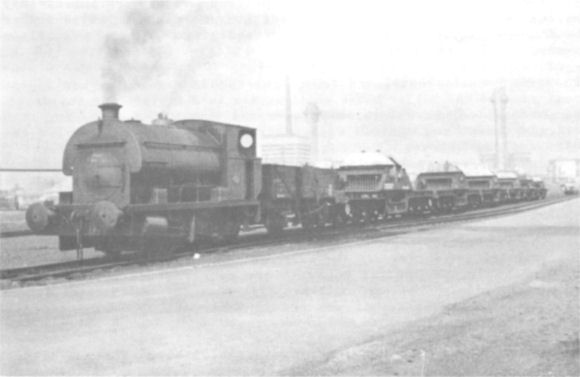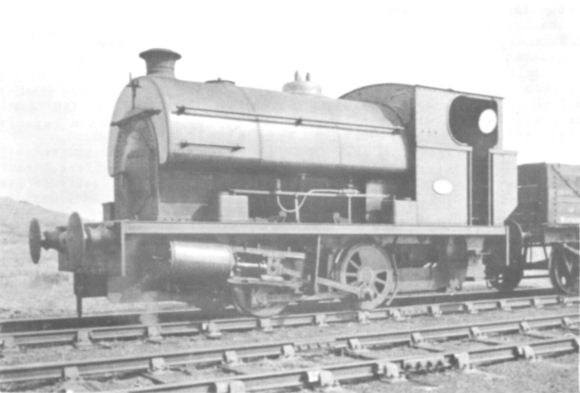
| THE INDUSTRIAL RAILWAY RECORD |
© FEBRUARY 1968 |
WINDSCALE WORKS
H. STUBBS
(This article on the Windscale Works of the United Kingdom Atomic Energy Authority first appeared in the April 1965 issue of "Nucleus", published by the Sellafield Area Sports & Recreational Association. We are indebted to the Editor, Mr E.J. Larkham, for permission to reproduce it here. – Hon. Eds.)
On the Cumberland coast south of St. Bees Head considerable activity occurred during the last War which was naturally not publicised, for here two Royal Ordnance Factories were built and were busily producing T.N.T. during the whole of the hostilities. One of these factories was at Sellafield and it was here that a new spate of activity began during 1947. The little-known Sellafield factory changed its name at this time and in due course the name Windscale became almost a household word and its connection with the Atomic Energy Industry very widely known indeed.
Before this could happen, however, much heavy construction work was necessary and the moribund Sellafield factory, in the intervening time between the cessation of T.N.T. manufacture and the decision to use the site for the country’s first large scale atomic piles, had quietly been getting rid of equipment as surplus. Thus the original stock of shunting locomotives had gradually been reduced to one, and even this one was redundant when, almost overnight it seemed, this engine found itself extremely busy. The British Railways marshalling yard at Sellafield became choc-a-bloc with wagons of all types loaded with heavy girders, steel plates, concrete and all the paraphernalia of a large building project. Soon one engine only was incapable of dealing with the flood of materials and more were sought and obtained quickly enough from other establishments less lucky than the erstwhile Sellafield R.O.F. in finding alternative work.
Five[*] engines eventually comprised the stud. They were:-
| Peckett 2027 of 1942 | 0-4-0 saddle tank | (the original Sellafield engine) |
| Peckett 2072 of 1945 | 0-4-0 saddle tank | (ex ROF Bishopton [‡]) |
| Barclay 2084 of 1940 | 0-4-0 saddle tank | (comparable to the two Pecketts; |
| ex ROF Drigg, the second and neighbouring
Cumberland Ordnance Factory) |
||
| Peckett | 0-4-0 saddle tank | (small loco ex Admiralty) |
| Ruston & Hornsby | 4-wheel diesel | (ex Ministry of Supply, Capenhurst, |
| an establishment which later became a UKAEA works.) | ||


No.1 (Peckett 2027) at work and at rest, April 1967. (collection R.A. Bowen)
All except the Ruston & Hornsby engine were put to work immediately. The diesel was in a completely run-down condition and was overhauled and repaired by the Windscale staff. It was then disposed of and did not actually work at Windscale.
The tiny Peckett engine was for a time used for shunting odd wagons from the coal dump to the boiler house until in its turn it left for duties to which it was more suited, much I think to everyone’s secret regret, for it had an endearingly quaint and comical appearance. It needed much heavier and more powerful engines however to bring heavily laden bogie bolsters and 20-ton fully laden coal wagons into the Works up the stiff gradient from the marshalling yard on a practically continuous curve and, after a few brief yards on the level, to resume climbing to the site of the new construction work at the northern end of the enclosed area.
The three remaining engines coped efficiently with the considerable traffic flowing into the new Works. In the case of the original engine, it now entered on a new phase because it was early in the construction period that it was converted from oil to coal burning. The risk of using coal burning locomotives on explosives factories is obvious and to lessen this risk, the Sellafield engines were originally supplied new as oil burners.
Getting up steam each morning with these oil burners was a distressing experience for those unfortunates working in the vicinity of the shed. The air drawn in by the burners and the effects of combustion set up a considerable throbbing which could be felt unpleasantly in the adjacent machine shop and main stores building. It was agreed that this need not be tolerated since the necessity for oil burners no longer existed. Consequently it was decided to revert to coal firing and the conversion was readily carried out on the plant. The oil tanks, burners and associated pipework were removed and firebars fitted. An ashpan and dampers were made at Windscale and instead of a side bunker on the footplate for coal, which is the usual place for it in this type of engine, a small bunker was attached to the rear of the cab. It had always occurred to me that these engines bore a sneaking resemblance to a Manx cat with their flat cab back sheets down to frame level. The bunker, which had a capacity of 15-cwts, remedied that.
From the point of view of appearance I always had an affection for the Andrew Barclay engine. In saying this, I have no wish to detract from the sterling worth of the other engines in any way. The saddle tank of this engine had a gently curving top, merging into vertical flat sides. This gave a tank of adequate capacity with a lower line than the Pecketts and this, together with slightly larger driving wheels, gave it a less top-heavy appearance.
The engines were numbered by the rather cumbersome method of prefixing their book numbers with the type or class number in the Capital Assets register and also the symbol denoting which of the Authority’s works they belonged to. Properly therefore Peckett 2027 should display the legend 4300/B/0001. This means a steam locomotive (4300), belonging to Windscale Works (B), and No.1 of a series (0001). This latter indicates a generous provision for adding to the locomotive stud at Windscale! Needless to say this information (which had to be put on somewhere) was recorded on a small plate attached to the rear of the bunker and the number ‘1’ was painted on the cab sides and also on the front buffer beam with the addition of ‘No.’.
A small two-road shed is provided for housing the engines. Looking into the shed from the locomotive entrance, the left hand road has a pit practically the whole length, and is capable of taking two of the bigger engines between the doors and the buffer stops at the pit’s extremity. The right hand road has no pit and is not restricted by buffer stops and can take therefore two engines such as the larger Peckett and one small steam or diesel engine similar to the ones already mentioned. A water tower is located just outside the shed, and on the side adjacent to the pit is a small fitting shop, a mess room and a small stores. It was never the policy to undertake major overhauls at Windscale and, as an instance, no lathe big enough to swing the driving wheels for tyre turning existed on the site. Such work as this was therefore contracted out, the stripping and erecting being done by the Windscale staff. Some fairly extensive repairs, however, have been carried out by the Windscale staff such as boiler retubing and of course the conversion already referred to, and in one instance necessitated by the accidental destruction by fire of the original wood lagging, the re-lagging of a boiler.
A marked feature of all these engines has always been the care and attention given to keeping them in spotless condition. The paintwork has been preserved and cleaned assiduously and all brass parts such as dome covers, safety valve columns, whistles, etc., polished to a state of gleaming perfection. Although small in comparison with any BR locomotives they came alongside in the Sellafield yard, they made the majority of these appear shabbier than usual.
* The Club records list two other 0-4-0 saddle tanks at Sellafield – Peckett 2028 (ex-works 5th August 1942) and Peckett 2030 (ex- works 16th September 1942). These two, together with Peckett 2027 (ex-works 6th July 1942) would no doubt comprise the "original stock" referred to by the author. – Hon. Eds.
‡ According to the Club records this locomotive was ordered by the Ministry of Works, 122 George Street, Edinburgh 2. It was ex−works on 2nd July 1945 but its destination is not known. It is thought to have gone to the Ministry of Supply depot at Orbiston, Motherwell, which was taken over by Metropolitan-Vickers in October 1947. It travelled from Orbiston to Sellafield in June 1948 (according to a British Railways Movement notice) but whether it went to Bishopton before this is not known. Further information would be welcome. – Hon. Eds.
☼☼☼☼☼☼☼☼☼☼☼☼☼☼☼☼☼☼☼☼☼☼☼☼☼☼☼☼☼☼☼☼
"In 1891 … special pit stretchers were designed with hinge and forked feet so that they could be placed on ordinary hutch axles and wheeled along the hutch rails. A special stretcher was also designed to permit the patient being brought up from the pit bottom in either a horizontal or a vertical position and it could be placed in the pit cage when the cage or shaft was too narrow for the stretcher to be brought up at full length, so the patient could be moved in a sitting position."
(From the story of the St. Andrew’s Ambulance Association in Glasgow, appearing in the March 1966 issue of the "St. John Review". – S.A.L.)